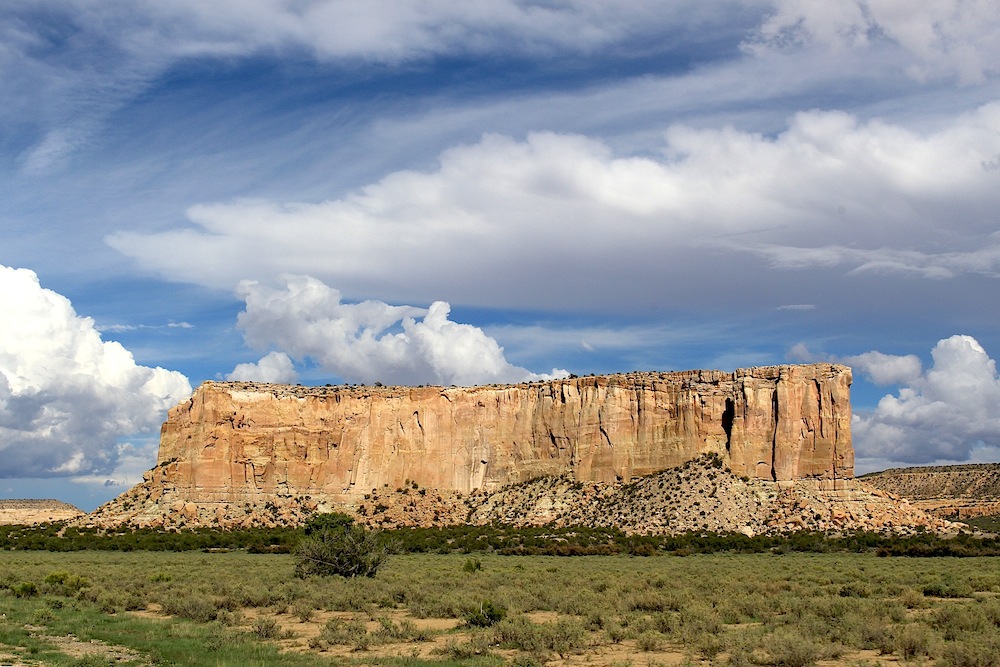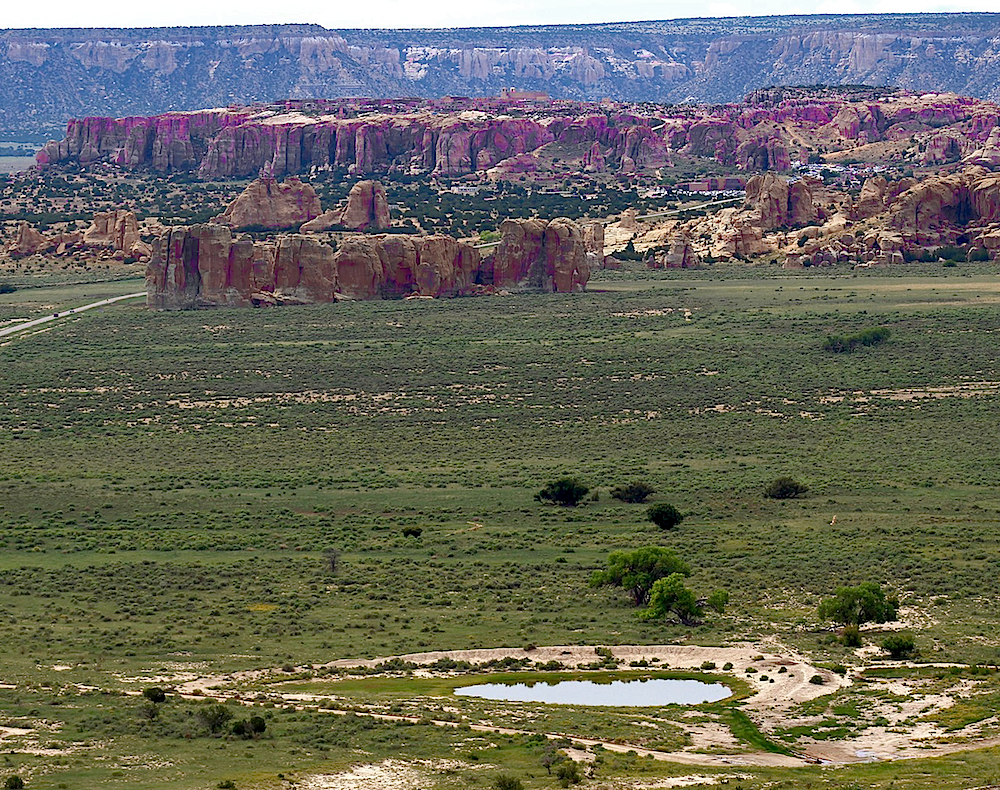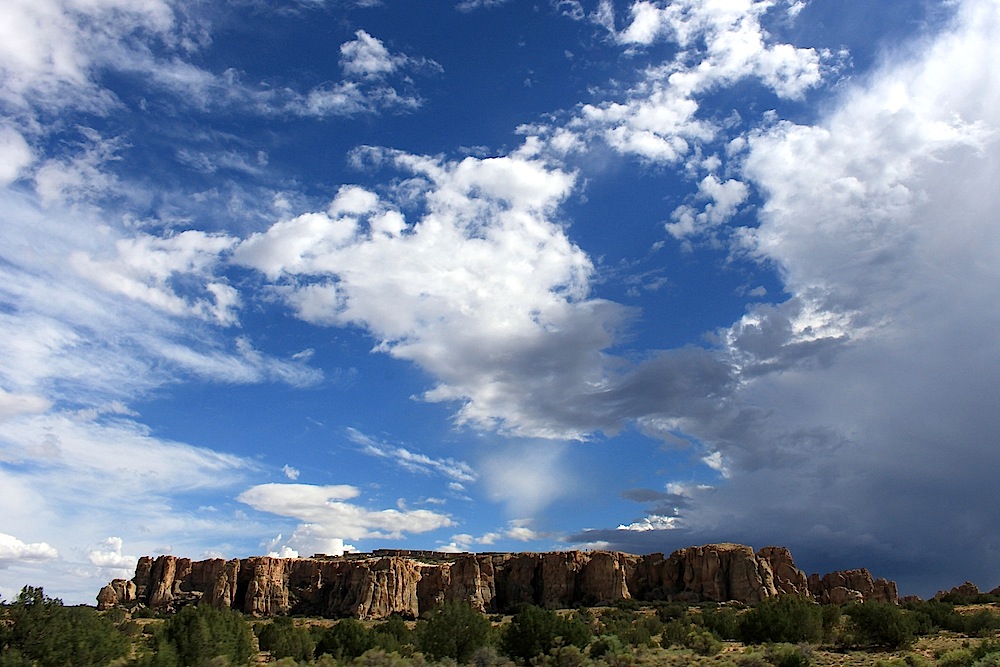Day Trip: Feast of San Estevan, Acoma Pueblo
by Bruce • September 16, 2018 • Roadies • 1 Comment
If September 2nd rolls around and you are in central New Mexico looking for something to do, consider attending the Feast Day of San Estevan at Acoma Pueblo.
I offer this up as a native New Mexican who, up until three Sundays ago, had never attended a formal feast day at any pueblo before.
Earlier this summer, though, my folks let me know they had planned to attend the event in early September, and a month ago they reminded me about it and asked me if I wanted to join them for the day trip.
I don’t know why I had to think about it. After all, it was to Acoma Pueblo.
—
Acoma Rock, the locus of Acoma Pueblo life and long the home of the Acoma people, is a 350-foot high mesa that sits in a wide desert plain in western New Mexico, 60-some miles west of Albuquerque. A thousand years ago, a native community decided to settle on top of the rock, and those people and their descendants continued to live on it and call it home up until today.
The Acomas’ mesa top home has been dubbed Sky City because it is truly a city on high, and once you climb up through the craggy walls of the rock (or take the more recently installed road up) and arrive on top, you are overwhelmed by views of the expansive plain beneath you, of the ancient town that spreads out around you, and of the deep and spiritual skies above you. The location’s immense beauty helps you to understand why the Acoma embraced it as a hallowed place.
Normally, access to the elevated pueblo is relatively limited to visitors, except for those who are taken on top by Acoma guides who provide controlled tours.
There are two days of the year, though, that the non-native visitor can come to the pueblo and roam freely on the mesa top and be welcomed as one of the community: on Christmas Eve, when traditional dances are performed in the old mission, and on September 2, when Acomas from near and far return to the rock for a homecoming of sorts on the Feast Day of San Esteban.
—
Three Sundays ago was September 2nd, so at about 9 that morning my folks and I left Albuquerque and drove I-40 west towards Grants and the Acoma turn-off, where we would head on over to Sky City.

An indifferent horse on a Laguna pueblo backroad.
It knew where it was going, and didn’t care where we were headed.
As we neared our destination, our drive brought us to stop briefly at a scenic overlook across the valley from the pueblo mesa. There, a few vehicles were parked and a handful of Acoma artists had tables set up to sell their wares- pottery mostly. We visited with the vendors, learning that most of them were related, and after making our first purchases of the day, we enjoyed a photo op with them and then I snapped a few morning photos of the distant pueblo with my camera and then we hopped back in the car to descend the hill and to cross the valley to Acoma.

A nice meeting at the overlook: Mom with Eva Lewis (far right), her friend (center), and her two sons, Lucas and Mavis, who are also potters. Acoma Rock is in the background to the left.
Being a few years (well, probably twenty) since I had last visited the pueblo, I had forgotten that the approach to the mesa was littered with other interesting rock formations and unique boulders. We took liberties and briefly stopped the car on the road and photographed several of them as other cars coming or going allowed us to.
When we arrived at the Sky City Visitors Center parking area, we realized that our efforts to be at the pueblo early to avoid crowds were thwarted. Not only were the several lots around the Center full of cars, but so were lots on up the road towards the pueblo, and vehicles were also parked on the shoulders of every side road. The line at the Visitors Center for boarding shuttles for a ride to the top was already several hundred people deep. My folks understood when I mentioned I would go ahead and take the hiking path up and meet them somewhere on top.
—
To climb to the top of the mesa, you walk on up the access road until a gap in the concrete siding to your left exposes a trail that turns at a crevice in the rock before you. Soon, the crevice becomes a rock staircase with thin and narrow steps- ancient steps- that are complimented by smooth divets in the walls above them, ancient handholds worn into the stone by centuries of use. The staircase takes you quickly up several hundred feet until, like that, you are on top of the mesa, looking at an old small home near the trail head.
Once you are on top, wandering the dirt lanes behind and before the long rows of adobe homes that seal in each lane, you feel yourself transported in time.
Seemingly half of the population is dressed out in colorful performance costumes, the native dance participants covering a full range of ages while also representing different clans of the Acoma.
In front of many homes are vendor booths, where pottery, jewelry, curios, snacks and drinks are sold.
When you come near the pueblo square, which is surrounded on three sides by multi-storied structures, you see the tops of these buildings are already populated by spectators, waiting for the next set of dances to begin.
When a dance will begin, a cluster of men, several with drums, meet in one corner of the plaza and speak briefly, and then the rhythm of drumming rises, and the men sing songs written for the weekend, written for their people to dance to, and then the plaza fills with the dancers- women in colorful dresses with thin squarish painted plates standing on their heads, men bare chested except for supporting sashes, elbows and knees wrapped in leather straps, bells attached to their legs that ring when they hop from leg to leg in their moccasinned feet. Both the men and women clutch a branch of a fir tree in each of their hands, rounding out their apparel as dancers.
—
The day was magical.
After arriving on top, my first local acquaintance was Kelly, a man I met while walking on a back street. With a round shaven head and a moist face, he was smiling and was talking with a mumble and laughing loudly with a woman near him, and as she left him he turned and began to talk to me. He reminded me of a heyoka- a sacred jester from Native lore- because his eyes twinkled and his sentences each ended with a giggle, and he was clearly inebriated. He told me a few stories about his life, and his dad who had been in the army, and about a mischievous handsome guy he had once knew named Tommy who was always getting in trouble, each tale rife with giggles and details I could not make out, but he was friendly. Neighbors who walked by would address us knowingly, in friendly tones. At the end of a partial, incomprehensible yarn, I told him I was glad to meet him and thanked him for welcoming me to Acoma. He laughed and then we hugged and I told him I’d see him later, because I knew I would, since we were both spending the day on top of a rock, and he said goodbye and then followed me up the path I was on to the next road over.
This second road I entered was wide and a bit more busy, but a shadowed banco sat in front of the houses on the east side of it, where many locals were already sitting and watching people passing or eating or talking. I walked a little ways and saw a thin man in his thirties sitting alone in front of one house, and I asked him if I could join him. He was an Acoma son, back for the day. Behind him was his parent’s home where, inside, his family prepared food. His father was a State Representative. He lived down in Acoma the town, where he ran a food business. We talked about the area and the meaning of the feast day. No, he wasn’t Catholic- he had returned to the religion of his ancient people, for the most part, to its philosophies on life and the earth and the cycles and seasons. We chatted for a half an hour before he needed to go find his kids, and it helped me to contextualize the day quite a bit.
Soon, drum beats began from the plaza, and the dusty roads filled with tourists and dancers, and I spent the bulk of the afternoon wandering and looking.
The hardest part of the day lay in the fact that cameras could not be taken or used on top, and at every corner, beyond every booth, across every lane were images that I badly wanted to capture.
The biggest of these experiences came late in the afternoon. I had returned to the plaza and decided I wanted to see what it was like to climb on top of one of the adjacent buildings and watch a dance from above. I ascended the steep ladder stairs of one building and joined a throng on a plaza-side roof. I could look down on the plaza and see the chanting men in a circle around several drummers. I could see dancers filling the plaza and snaking east and west on the connecting roads, hopping and spinning before the spectators lining every free space upon them, absorbed in the rhythmic display. I could also look to my right and see the ancient Spanish mission sitting white in the sun in the fore before a mass of gray clouds behind it. I could look straight ahead and see the edge of the mesa beyond the roads and the little adobe houses, and then on into the broad valley beyond it where birds wheeled off towards Enchanted Mesa several miles away. Behind me, the sky was darkening as a mass of monsoon clouds filled the western sky. Above me, the sun shown fully on the pageant, without heat, diffused by cool afternoon breezes. Beyond the mesa, the ancient desert spread silently, austere and magnificent, to meet hills and mountains and buttes rising from the valley floor.

Enchanted Mesa, which sits three miles northeast of Acoma Rock, has remained inaccessible and unsettled over the years, despite its proximity to the pueblo.
It was mystically beautiful.
I ran into my parents a few times wandering around the limited lanes on the mesa. We set times to periodically meet, but we separated to keep wandering and looking. I visited the mission chapel and walked around the perimeter of the great graveyard in front of the church. I perused the various stalls scattered all over the streets. I found an artist’s booth that featured a piece of quail pottery that I thought was unique and would make a great souvenir from the day. I left that booth intent on revisiting it as I continued to look at what other vendors were selling. I watched several more dances and walked around the periphery of the place three times. I got hot and decided I needed a snow cone. I went back to the quail artist and bought a bird to bring home for my tiny pottery collection.
I did the second-story viewing of the dance, and afterwards, as the dark clouds approached from the west, it was nearing 4 PM, and it seemed a good time to try and find my folks. As I went around the mesa top again towards the chapel, I stumbled across my dad who was also looking for me.
“Are you ready to go?” he asked.
“Yeah.”
“Your mom is waiting for us over by the van queue.”
“Could I have you guys carry this bag down for me to the bottom? I am going to take the trail back down.”
“Sure. See you at the bottom.”
I retraced my steps back to the head of the trail down, where other visitors were beginning their descent. The air cooled. The steps down felt steeper and shallower than they had on the way up. The climb was slow but fun.
I walked on down the access road back to the Visitor Center, where I found my dad out by his car, and my mom was using the facilities. The storm we thought would accost us never arrived, and the sunlight poured warmly on us and the mesa, bronzing the rock. The light was lovely, and to my joy, my dad said we had all the time in the world, and he pulled over and said for me and my mom to go take some pictures of the landscapes around us, and we did. I was grateful he gave us time to do that.
My folks had had a great time themselves, and they had taken advantage of an offer by a family to enter their house for a meal. I had been invited by two people during the afternoon to go into their houses for a lunch, and after the fact, I was a little disappointed that I hadn’t accepted one of them- if only to eat a privately prepared meal in one of these ancient homes with several of these people. The Acoma hospitality was so amazingly generous to us visitors.
We took our time heading back towards I-40, stopping a few times to photograph clouds, buttes, and horses in the open space. Once we were on the freeway, we stopped by the old bridge in Rio Puerco at The 66 Pit Stop for Laguna Burgers to round out the day. When we arrived back in Albuquerque, it was near sunset and we were a little surprised that our day trip had kept us away for the day.

My bounty from the day- a seed pot from potter Eva Lewis we met at that morning’s stop at the overlook point, and a dotted quail, made by Acoma artist Karen Aragon, currently residing in Alamogordo. I have long favored Acoma pottery for its symbols and color scheme.
But a feast day on top of the mesa at Acoma Pueblo deserved the bulk of our day.
It would deserve a bulk of yours too.
—
I’ve heard after the fact that if you could attend only one pueblo feast day to give you a sample of the rich culture and heritage and spirit of a people, the Feast Day of San Estevan at Acoma Pueblo is it. I’d be hard pressed to challenge that notion. At Acoma, the mesa itself helps you to understand why these people are unique.
If you cannot wait until next September to spend time with the Acoma in their community at the the pueblo, make plans to visit them on Christmas Eve, when luminarias will light your way on the mesa top lanes to the mission chapel.
I’ll probably see you up there.









One Response to Day Trip: Feast of San Estevan, Acoma Pueblo